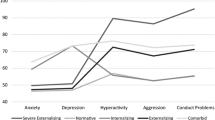Abstract
The day treatment model has been supported by research over the past decade, and has now evolved to include partial-day programs. Partial programs are attended for as little as 3 hours per day, in contrast to the 6–8-hour full day setting. Partial settings offer the added advantage of allowing children to continue in their regular school programs. Program evaluation must occur to discover whether these less intensive services can be effective in treating children with severe emotional disorders (SED). The Youth Outcome Questionnaire (Y-OQ) was used to examine group means, collected from successive admissions to the program during 1997–98. Data were collected from a total of 215 children (158 boys and 57girls), 5 to 13 years of age. All children were exhibiting emotional symptoms beyond the scope of outpatient services, with 92% being classified as having SED. Assessment was ongoing, with a median of 7 weeks between administrations of the Y-OQ. Group Y-OQ means were noted to decrease significantly at the second and third assessment, with 18% of the group scoring within the normal range of behavior at the third administration.
Similar content being viewed by others
References
Achenbach, T.M. (1991). Manual for the child behavior checklist and 1991 profile. Burlington: University of Vermont, Department of Psychiatry.
Barker, P. (1993). The future of residential treatment for children. In C.E. Schaefer & A.J. Swanson (Eds.), Children in residential care: Critical issues in treatment (pp. 1-16). Northvale, NJ: Jason Aronson.
Brandenberg, N., Friedman, R. & Silver, S. (1990). The epidemiology of childhood psychiatric disorders: Prevalence findings from recent studies. Journal of the American Academy of Child and Adolescent Psychiatry 29, 76-83.
Burlingame, G.M., Wells, M.G., Hoag, M.J., Hope, C.A., Nebeker, R.S., Konkel, K., McCollam, P., Peterson, G., Lambert, M.J., Latkowski, M., Ferre, R.& Reisinger C.W. (1996). Administration and scoring manual for the Y-OQ. American Credentialing Services.
Burns, B.J. & Taube, C.A. (1990). Mental health services for adolescents. Background paper for U.S. Congress, Office of Technology Assessment's Adolescent Health Project.
Friedman, R.M., Katz-Levey, J.W., Manderschied, R.W. & Sondheimer, D.L. (1996). Prevalence of serious emotional disturbance in children and adolescents. In Manderscheid, R.W., & Sonnenschein,M.A. (Eds.), Mental health, United States (pp. 71-78). Rockville, MD: Center for Mental Health Services.
Jacobson, N.S. & Truax, P. (1991). Clinical significance: A statistical approach to defining meaningful change in psychotherapy research. Journal of Consulting and Clinical Psychology, 59, 12-19.
Jones, M.L., Eyberg, S.M., Adams, C.D. & Boggs, S.R. (1998). Treatment acceptability of behavioral interventions for children: An assessment by mothers of children with disruptive behavior disorders. Child & Family Behavior Therapy 20(4), 15-26.
Kazdin, A.E., Siegel, T.C. & Bass, D. (1990). Drawing on clinical practice to inform research on child and adolescent psychotherapy: Survey of practitioners. Professional Psychology: Research and Practice, 21 (3), 189-198.
Martens, B.K., Peterson, R.L., Witt, J.C. & Cirone, S. (1986). Teacher perceptions of school-based interventions. Exceptional Children, 53, 213-223.
McGinnis, E. & Goldstein, A. P. (1997). Skillstreaming the elementary child: New strategies and perspectives for teaching prosocial skills. Champaign, IL: Research Press.
Nothmann, J. & Acosta, O. (1999). Directory of expanded school mental health programs. Baltimore: University of Maryland, Center for School Mental Health Assistance.
O'Neil, R.E., Horner, R.H., Albin, R.W., Storey, K. & Sprague, J.R. (1990). Functional analysis of problem behavior: A practical assessment guide. DeKalb, IL: Sycamore Publishing.
Patrick, C., Padgett, D.K., Burns, B.J., Schlesinger, H.J. & Cohen, J. (1993). Use of inpatient services by a national population: Do benefits make a difference? Journal of the American Academy of Child and Adolescent Psychiatry, 32(1), 144-152.
Prevost, J. (1981). Partial hospitalization: Dynamics of underutilization. In Proceedings of the Annual Conference on Partial Hospitalization. San Diego, CA: American Association for Partial Hospitalization.
Pruitt, D.B. & Kiser, L.J. (1991). Day treatment: Past, present and future. In M. Lewis (Ed.), Child and adolescent psychiatry: A comprehensive textbook (pp. 878-890). Baltimore: Williams & Wilkins.
Reimers, T.M., Wacker, D.P. & Cooper, L.J. (1991). Evaluation of the acceptability of treatments for children's behavioral difficulties: Ratings by parents receiving services in an outpatient clinic. Child and Family Behavior Therapy, 13(2), 53-71.
Robinson, K.E. (In press). Outcomes of a school-based mental health program for children with SED.
Robinson, K.E., Dow, R.T. & Nicholas, P.M. (1999). Expanding a continuum of care: A report on a partial day treatment program. Child & Youth Care Forum, 28(3), 221-228.
Sayegh, L. & Grizenko, N. (1991). Studies of the effectiveness of day treatment programs for children. Canadian Journal of Psychiatry, 36, 246-253.
Shaffer, D., Fisher, P., Dulcan, M. K., Davies, M., Piacentini, J., Schwab-Stone, M.E., Lahey, B. B., Bourdon, K., Jensen, P.S., Bird, H.R., Canino, G. & Regier, D. A. (1996). The NIMH diagnostic interview schedule for children version 2.3 (DISC-2.3): Description, acceptability, prevalence rates, and performance in the MECA study. Methods for the epidemiology of child and adolescent mental disorders study. Journal of the American Academy of Child and Adolescent Psychiatry, 35, 865-877.
Sheridan, S. M. (1995). The tough kid social skills book. Longmont, CO: Sopris West.
Stroul, B.A. & Friedman, R.M. (1996). A system of care for seriously emotionally disturbed children and youth. Washington, DC: CASSP Technical Assistance Center, Georgetown University Child Development Center.
U.S. Department of Health and Human Services. (1996). Prevalence of serious emotional disturbance in children and adolescents. In Mental Health, United States. Center for Mental Health Services, Substance Abuse and Mental Health Services Administration [http://www.mentalhealth.org/cmhs/index.htm].
Weisz, J.R., Weiss, B., Morton, T., Granger, D. & Han, S. (1992). Meta-analysis of psychotherapy outcome research with children and adolescents. Unpublished manuscript, University of California, Los Angeles.
Author information
Authors and Affiliations
Rights and permissions
About this article
Cite this article
Robinson, K.E. Outcomes of a Partial-Day Treatment Program for Referred Children. Child & Youth Care Forum 29, 127–137 (2000). https://doi.org/10.1023/A:1009453428705
Issue Date:
DOI: https://doi.org/10.1023/A:1009453428705



